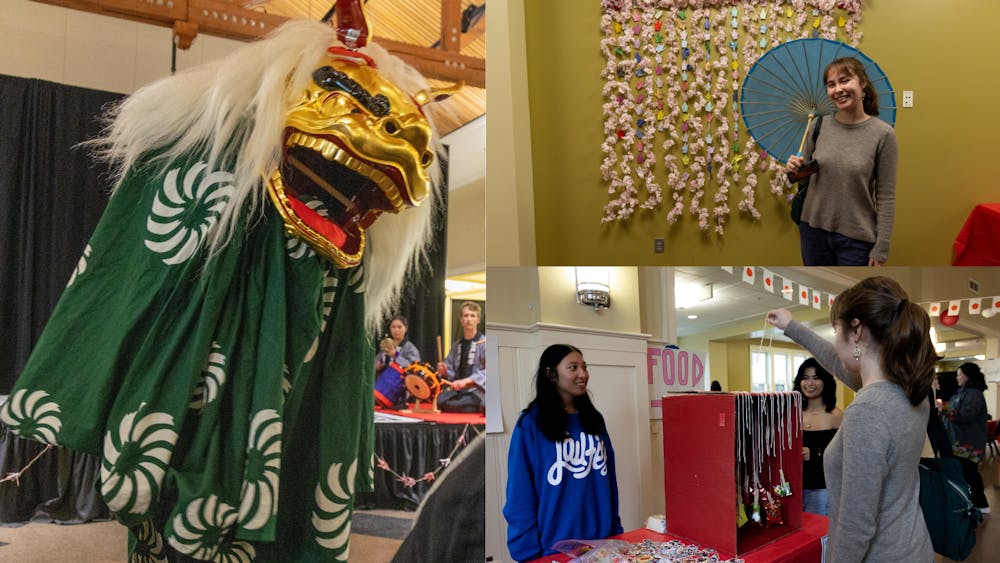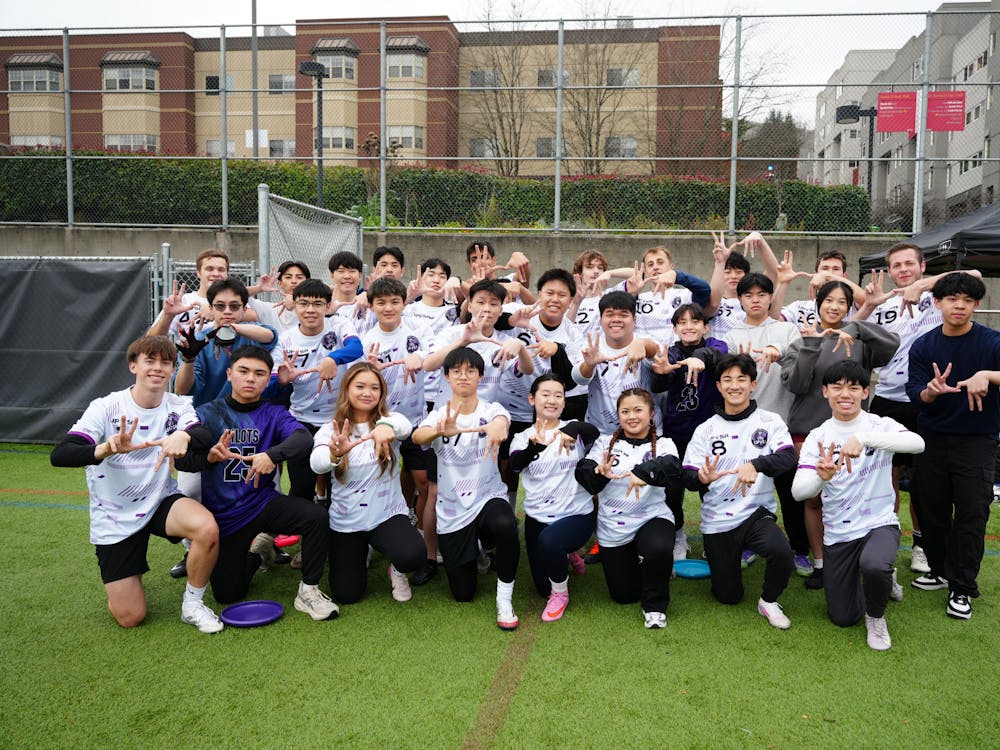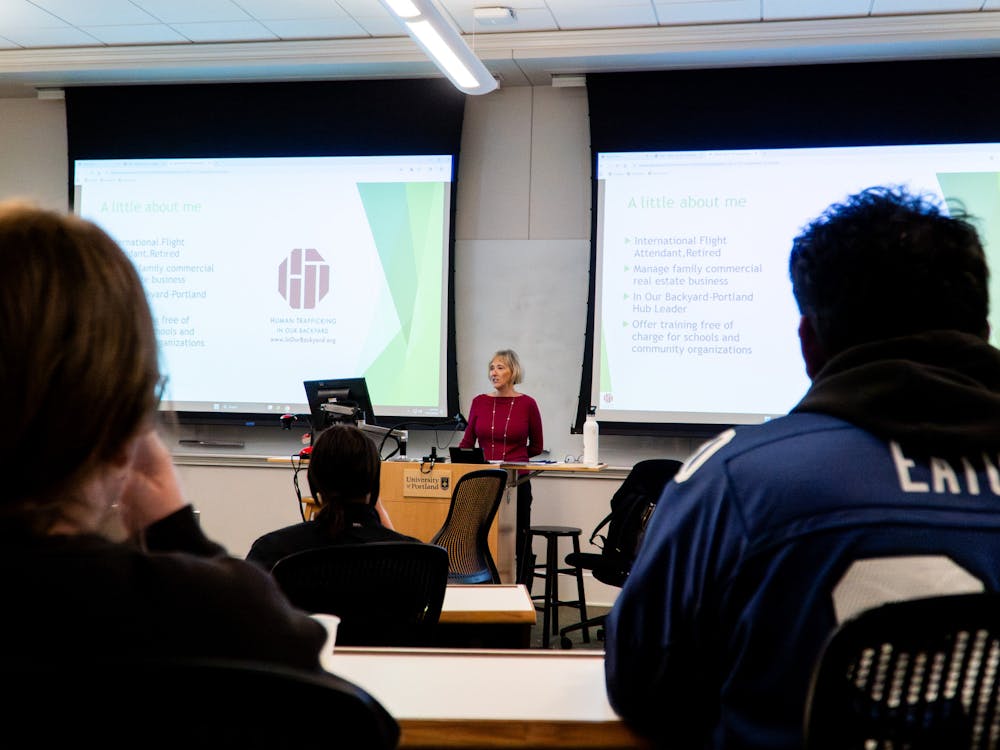The plastic fish weren’t biting, and I let my paper net disintegrate into the water with defeat. I had attempted kingyo-suki for the first, though not last, time. My only consolation was that the game must be rigged.
“Kingyo-suki is a really popular [Haru Matsuri game],” Noelle Asato, Japanese Student Association (JSA) co-vice president, said. “Usually there’s live goldfishes swimming around and you have a little scooper, but it’s like tissue paper. When you try to scoop [the fish], they fall out. It’s a little frustrating but it's a fun game and you [typically] get to take home the goldfish.”
JSA’s fourth annual Haru Matsuri began early evening on Saturday March 23 where UP and Portland community members filtered into the Quiet Side of the Commons to enjoy a night of traditional games, food, dance and music.
“Haru Matsuri” directly translates to spring festival and encompasses a variety of events which occur in the spring. Community-building remains a major component wherever these festivals are held.
Co-President Lannie Hisashima finds the annual Haru Matsuri to be an event of outreach for the Portland community.
“Each year, [Haru Matsuri] gets stronger and stronger,” Hisashima said. “We get more food vendors, we get more established, more performances. It’s just every year, bettering ourselves [in] being more prepared for [the event] and putting on an even better event for the community.”
Often made affordable and open to the public, cultural events like JSA’s Haru Matsuri function as gateways to connect UP community members with their greater Portland area.
Japanese-American communities have thrived in Portland for decades — notably within the city’s plethora of Shin Buddhist temples and widely known Japanese-American Museum.
To celebrate these vibrant communities, JSA highlighted local performers and food vendors throughout the evening.
“[My favorite part of Haru Matsuri] is just the food vendors. I love supporting our small businesses,” Haley Brown, co-president of JSA, said. “[I enjoy] having all these people come and enjoy the food and say all these positive things about it.”
Cradled within their plastic box, three mochis caught my eye: a strawberry daifuku, ube custard daifuku and sakura mochi. Hailing from Tomomochi, the Hawaiian-Portland based brand was just one of many local vendors featured.
“I was really excited to be making the sakura mochi the most, because of it being the springtime,” Camden Tomomotsu, owner of Tomomochi, said. “I also just don’t see this much [of Japanese events] in Portland. I’m excited to see a bunch of Japanese people.”
The fragrant sakura mochi took me back to my elementary school days when my dad made me flower soups for lunch. Nostalgia from the Haru Matsuri’s food and performances was a common theme for many participants.
“I look forward to the food,” Isabelle Takane, a UP sophomore, said. “It’s usually what I can eat at home, but not something I always have here.”
The other events, including a calligraphy station and ikebana flower arrangement, were packed with families and students looking to get the most out of the night. Over the J-pop music playing in the background, JSA officers had to remind people to share the flower supplies amongst everyone.
I took my fair share of seven flowers and moved towards the assembling table, which was littered with flower stems and petals. Self-consciously, I arranged my ikebana amidst other students who had come up with intricate arrangements.
In addition to the Kit Kat and Hello Kitty keychain in my satchel (my winnings from the night), I stuffed the finished floral product into my bag’s front pocket. Nearby, people were leaving the calligraphy table, and I quickly grabbed a seat and brush-pen.
Another person was outlining the word “sakura” as I settled on drawing the characters of my name. I sent my dad a photo of my art, to which he replied: “There should be ‘-’ between み and る.”
After the somewhat failed spelling of my own name, I decided to stop hoarding the calligraphy ink and move back towards the games. Small kids played shateki with rubber bands — doing far better at shooting down the cups than I had.
At every turn, groups of friends, families and couples were alongside me — winning pens, drinking boba and arranging flowers.
UP senior Mia Tamarra has also made memories attending JSA functions. Tamarra spent her first date at a previous Haru Matsuri, which has since turned the event into a positive space for her and her loved ones.
“Haru Matsuri has always been a fun event,” Tamarra said. “[Me and my boyfriend’s] first Haru Matsuri was our first actual date. Ever since, this has always been a place of good vibes and good memories. I’m glad I'm getting to spend my last [Haru Matsuri here] again.”
Eventually, the activity surrounding the food and games moved towards the back of the room, where a speaker introduced the Portland Shishimai Kai lion dancing performance. A lion-masked dancer appeared with three musicians on a stage.
The dancer stared into my eyes from behind his mask. People laughed as the lion played with an orange, wiggled his ears and snapped his masked jaw. We held our breath as we waited for the lion to leave the stage.
Soon, the shishi would come into the audience and begin biting us — an action that brings good luck for those bitten.
“The shishi embodies the deity, the shinto,” Hunter-Ishikawa, the shishimai performer, said. “In the old days, the shishimai dancer and musicians would walk down the street, especially during New Year’s time. Somebody in the house or business might say ‘hey, can you come bless their house,’ and then [they’ll] go in and do a purely ceremonial, non entertainment [ritual]. [...] Gradually over the years, [shishimai performances] started adding more entertainment factors.”
The shishi approached me and I placed a dollar bill in its mouth so that I, too, might receive good luck for the year.
Though today many shishimai and similar matsuri performances are secular, the Shinto and Buddhist roots of these productions remain significant for those concerned with preserving Japanese tradition, according to Hunter-Ishikawa.
“Going into the audience is definitely the best part,” Hunter-Ishikawa said. “[Before performing] I didn’t realize how happy everybody is when the shishi comes towards them. It doesn’t matter if it's the first time seeing the shishi or your hundredth time. No matter who you are there’s a smile. That’s definitely my favorite part, as well as preserving this tradition. Trying to accurately portray it exactly how it's done in Japan.”
The golden lion mask tapped me on my head. I smiled, knowing for a brief moment that I’d participated in a tradition not often accessible to me. The nearest Shinto shrine was 200 miles away, in Granite Falls, WA.
While the shishimai performance wrapped up and games resumed — the crowd was still anticipating the final item on the itinerary: the taiko performances.
Taiko drumming has built a Portland presence over the years, with the growth of groups such as Portland Taiko and Zenshin Daiko. Zenshin Daiko performed at the end of Haru Matsuri, along with Co-President Hisashima.
This time, the seats at the front of the stage filled quickly. I was left to stand on the side beside a family with their phones out, prepared to record videos.
The drumming built up slowly over time. I could feel the beating reverberate up my feet and into my heart. Accompanying the drumming were vocals, synchronized to the taiko’s beat.
Like the shishimai, the taiko performances became opportunities for the audience to participate. For the second song of the night, volunteers were asked to come up on stage and learn some drumming techniques. A child, barely bigger than the drum itself, approached the stage. The audience cheered the volunteers on, even throughout misplaced beats and dropped bachi sticks.
For the final song of the evening, a group of experienced taiko performers including Hisashima, took hold of the instruments.
The composition, “Omiyage,” featured more movements and vocals than any of the previous drummings. The players weaved in between one another, handing off their drumsticks and places to others. From afar, I could see the taiko’s physicality taking its toll on the players: red faces and heavy breathing were seen in nearly all the musicians.
Hisashima finds that playing taiko at Haru Matsuri was not only physically intense, but also emotionally charged.
“[Playing taiko tonight] was honestly very emotional,” Hisashima said. “I started when I was seven, so I’ve been playing for 14 years. This was probably my last performance — like ever. It's really daunting because this is such a big part of my life.”
As the taiko performers cooled off from their acts, JSA ended the evening with a raffle drawing for a collection of Smiskis.
The numbers “567–” were read aloud, and nearby I heard a person say, “dang it,” before the speaker finished reading the winning numbers.
That evening, someone walked away with three Smiskis in hand amidst a crowd of jealous people — myself included.
Though I had not won much of anything, I did have my mochi, my ikebana and my calligraphy. Ultimately, I knew that Haru Matsuri was not about the prizes, and that for many, the event was about seeking community, feeling nostalgia and preserving tradition.
But still, it felt good to win a keychain from catching enough fish with my paper net.
Camille Kuroiwa-Lewis is a reporter for The Beacon. She can be reached at kuroiwal26@up.edu.








